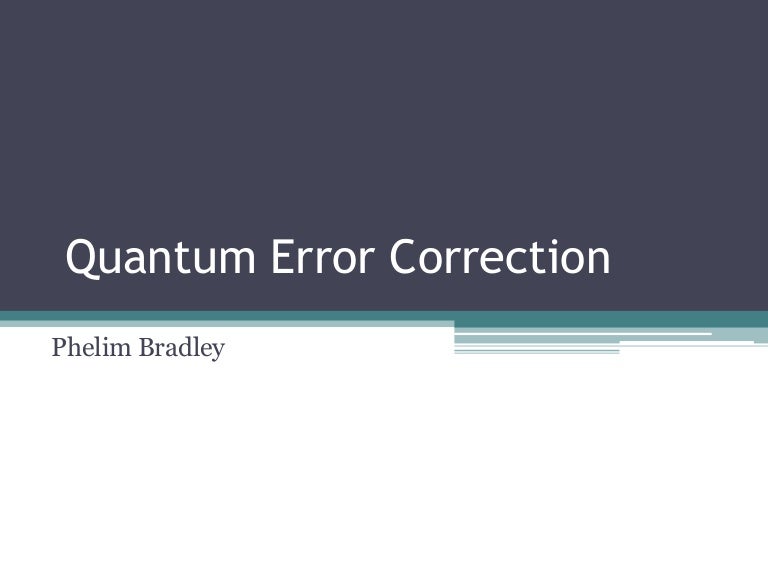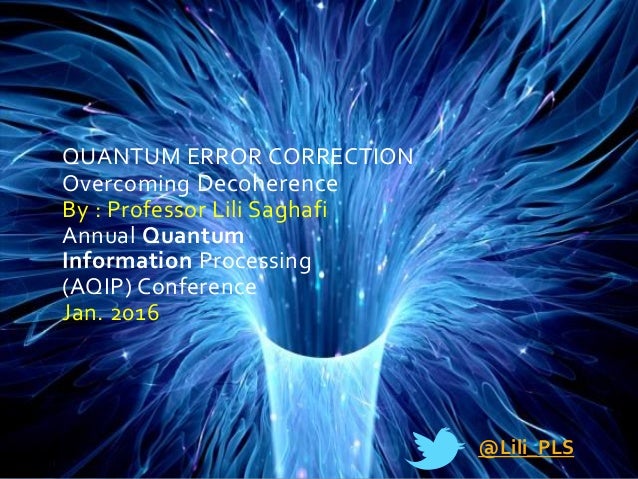

Edges represent the expected correlations due to data qubit errors (spacelike and spacetimelike) and measure qubit errors (timelike).
Alexei kitaev quantum error correction code#
Errors in the code trigger two detections (except at the ends of the chain), each represented by a node. The first (last) round also uses data qubit initialization (measurement) values to identify detection events.Ī, Detection event graph. The dark line is an average of the individual traces (grey lines) for each of the 10 measure qubits. e, Fraction of measurements (out of 80,000) that detected an error versus measurement round for the d = 11 phase-flip code. d, Illustration of error detection events that occur when a measurement disagrees with the previous round. Hadamard refers to the Hadamard gate, a quantum operation. Data qubits are randomly initialized into | + ⟩ or | − ⟩, followed by repeated application of XX stabilizer measurements and finally X-basis measurements of the data qubits.

c, Circuit schematic for the phase-flip code.

b, Pauli error rates for single-qubit and CZ gates and identification error rates for measurement, each benchmarked in simultaneous operation. In the experiment, the two codes use overlapping sets of qubits, which are offset in the figure for clarity. These experimental demonstrations provide a foundation for building a scalable fault-tolerant quantum computer with superconducting qubits.Ī, Layout of distance-11 repetition code and distance-2 surface code in the Sycamore processor. Finally, we perform error detection with a small logical qubit using the 2D surface code on the same device 18,19 and show that the results from both one- and two-dimensional codes agree with numerical simulations that use a simple depolarizing error model. We also introduce a method for analysing error correlations with high precision, allowing us to characterize error locality while performing quantum error correction. Crucially, this error suppression is stable over 50 rounds of error correction. Here we implement one-dimensional repetition codes embedded in a two-dimensional grid of superconducting qubits that demonstrate exponential suppression of bit-flip or phase-flip errors, reducing logical error per round more than 100-fold when increasing the number of qubits from 5 to 21. Errors on the encoded logical qubit state can be exponentially suppressed as the number of physical qubits grows, provided that the physical error rates are below a certain threshold and stable over the course of a computation. Quantum error correction 15-17 promises to bridge this divide by distributing quantum logical information across many physical qubits in such a way that errors can be detected and corrected. 2-9), but state-of-the-art quantum platforms typically have physical error rates near 10 -3 (refs. Many applications call for error rates as low as 10 -15 (refs.

Realizing the potential of quantum computing requires sufficiently low logical error rates 1. Zijun Chen, Kevin J Satzinger, Juan Atalaya, Alexander N Korotkov, Andrew Dunsworth, Daniel Sank, Chris Quintana, Matt McEwen, Rami Barends, Paul V Klimov, Sabrina Hong, Cody Jones, Andre Petukhov, Dvir Kafri, Sean Demura, Brian Burkett, Craig Gidney, Austin G Fowler, Alexandru Paler, Harald Putterman, Igor Aleiner, Frank Arute, Kunal Arya, Ryan Babbush, Joseph C Bardin, Andreas Bengtsson, Alexandre Bourassa, Michael Broughton, Bob B Buckley, David A Buell, Nicholas Bushnell, Benjamin Chiaro, Roberto Collins, William Courtney, Alan R Derk, Daniel Eppens, Catherine Erickson, Edward Farhi, Brooks Foxen, Marissa Giustina, Ami Greene, Jonathan A Gross, Matthew P Harrigan, Sean D Harrington, Jeremy Hilton, Alan Ho, Trent Huang, William J Huggins, L B Ioffe, Sergei V Isakov, Evan Jeffrey, Zhang Jiang, Kostyantyn Kechedzhi, Seon Kim, Alexei Kitaev, Fedor Kostritsa, David Landhuis, Pavel Laptev, Erik Lucero, Orion Martin, Jarrod R McClean, Trevor McCourt, Xiao Mi, Kevin C Miao, Masoud Mohseni, Shirin Montazeri, Wojciech Mruczkiewicz, Josh Mutus, Ofer Naaman, Matthew Neeley, Charles Neill, Michael Newman, Murphy Yuezhen Niu, Thomas E O'Brien, Alex Opremcak, Eric Ostby, Bálint Pató, Nicholas Redd, Pedram Roushan, Nicholas C Rubin, Vladimir Shvarts, Doug Strain, Marco Szalay, Matthew D Trevithick, Benjamin Villalonga, Theodore White, Z Jamie Yao, Ping Yeh, Juhwan Yoo, Adam Zalcman, Hartmut Neven, Sergio Boixo, Vadim Smelyanskiy, Yu Chen, Anthony Megrant, Julian Kelly


 0 kommentar(er)
0 kommentar(er)
